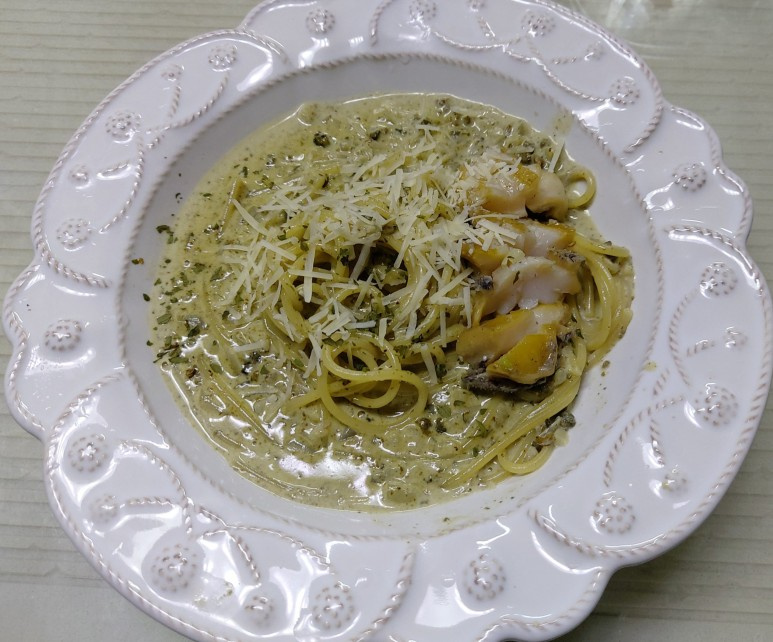Rich Abalone Liver Cream Pasta: A Taste of the Ocean
How to Make Abalone Liver Cream Pasta at Home

Discover the incredible transformation of abalone liver, often discarded! This recipe shows you how to create a deeply flavorful and luxurious cream pasta using fresh abalone liver from abalone dishes. The unique, savory richness of the abalone liver blends perfectly with the creamy sauce, creating an unforgettable culinary experience. While abalone liver can be used in both cream and oil-based pasta, today we’ll focus on the exquisite cream version. Remember, abalone is delicious from its meat to its very innards!
Ingredients- 1/2 Onion (finely chopped)
- 8 Abalone Livers (cleaned and prepared)
- 3 Abalone (cleaned and prepared)
- 1 Tbsp Minced Garlic
- 20g Butter
- 250cc Heavy Cream
- 2 Cheongyang Peppers (thinly sliced)
- 2 Tbsp Olive Oil
- 180g Spaghetti
Cooking Instructions
Step 1
First, thoroughly clean and prepare the abalone and their livers. If using pre-cleaned and frozen abalone parts, thaw them naturally. Thinly slice the Cheongyang peppers and finely chop the onion. Sear the prepared abalone pieces in a pan until lightly golden and set them aside. This preparation step will make the cooking process much smoother.

Step 2
Before blending the abalone livers, there’s a crucial step. In a pot, combine the abalone livers with about 1 ladleful (approx. 50ml) of water. Bring to a gentle simmer over medium-high heat for just 1 minute. Be careful not to overcook, as this can diminish the liver’s delicate flavor.

Step 3
Transfer the lightly blanched abalone livers to a blender. Add 150cc of heavy cream and blend until smooth. For an extra velvety texture, you can blend in batches. Simultaneously, bring a large pot of salted water to a boil for cooking the spaghetti.

Step 4
Add the spaghetti to the boiling salted water, along with 2-3 drops of olive oil. Cook for about 7-8 minutes, or 1-2 minutes less than the package instructions (al dente). This ensures the pasta will hold its texture when tossed with the sauce. Drain the pasta once cooked and set aside.

Step 5
In a deep skillet, heat 2 tablespoons of olive oil over medium-low heat. Add the minced garlic and sauté until fragrant, being careful not to burn it. In a separate small pan, melt 10g of butter and sear the prepared abalone pieces on both sides until nicely browned. Remove the seared abalone and set them aside.

Step 6
To the skillet with the garlic, add the remaining 10g of butter. Add the finely chopped onion and sauté over medium-low heat until the onion becomes translucent and tender. This slow sautéing process draws out the natural sweetness of the onions, enhancing the sauce’s flavor profile.

Step 7
Once the onions are softened, pour in the blended abalone liver sauce. Continue to cook over low heat, stirring gently as if simmering. This process mellows any potential gaminess from the liver and enriches the sauce with its unique savory essence.

Step 8
Add the remaining 100cc of heavy cream to the sauce in the skillet, stirring to create a rich and creamy consistency. Stir in half of the sliced Cheongyang peppers. These peppers will add a subtle hint of spice that balances the richness of the cream sauce.

Step 9
Add the al dente cooked spaghetti to the prepared cream sauce. Toss gently to ensure every strand of pasta is coated evenly. Season with salt to taste and a pinch of black pepper for added depth. If the sauce seems too thick, you can add a little of the reserved pasta water to reach your desired consistency.

Step 10
Plate the finished pasta attractively. Arrange the seared abalone pieces on top. Finish with a sprinkle of dried parsley and freshly grated cheese, if desired, for a beautiful presentation.

Step 11
For those who enjoy a bit more heat, garnish with the remaining sliced Cheongyang peppers. The fresh chili will provide a pleasant kick, cutting through the creaminess and making the dish even more vibrant. This combination offers a delightful balance of richness and spice.

Step 12
This recipe has shown you how to create a special cream pasta using abalone liver. Previously, you might have discarded the liver, but by cleaning and freezing it after preparing abalone dishes, you can transform it into an exquisite meal for special occasions or when you crave something unique. Abalone is truly delicious down to its very last part!




